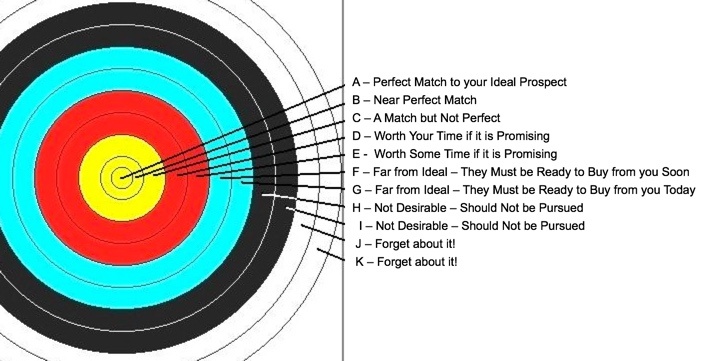- January 19, 2016
- Posted by: Dave Kurlan
- Category: Understanding the Sales Force

Now that we are nearly 3 weeks into the new year, have you changed anything with regard to goals, strategies or plans? How about targets? A few small tweaks to your targets can have a huge impact on revenue!
Targets are obvious but at the same time, misunderstood. Of course I have the usual baseball analogy, which I’ll skip along with the target analogies for golf, basketball, soccer, football and hockey. The analogy that works best for today’s topic is archery. In sales, when we talk about targets, most people immediately think about revenue and profit targets, and sometimes product units and/or shipment targets. However, today we will discuss the importance of having targets around your opportunities. Please take a moment to review the image below:

Each opportunity is scored based on how perfectly it is aligned with your ideal prospect/customer/client. Of course, that requires that you have the ability to define and describe a perfect customer. Can you? That would be the first challenge. The second challenge is to identify the criteria that would suggest and perhaps qualify that an opportunity is in alignment with your ideal. I suggest that companies choose from variables like the ten that follow:
- Prospect’s Revenue range or minimum
- Prospect’s Number of Employees range or minimum
- Contact person is the targeted Decision Maker
- Size of the opportunity
- Proximity to our sweet spot for application/deliverable/service/function/fit
- Opportunity can be leveraged
- Profit opportunity
- Probable Length of the Sales Cycle/Timing
- If there is Competition and/or Who the Competition is Likely to be
- Odds of Winning an Opportunity Like This
Each variable should be weighted according to importance, but to simplify the concept for this article, we will assign each criteria 10 points. Then, your opportunities can be scored like this:
- 100 points
- 90 points
- 80 points
- 70 points
- 60 points
- 50 points
- 40 points
- 30 points
- 20 points
- 10 points
- 0 points
We don’t score opportunities at Objective Management Group (OMG), but my sales consulting firm, Kurlan & Associates, scores every opportunity and does not pursue anything below a “D.”
I even score my keynote speaking opportunities, but my criteria is quite different than the criteria for Kurlan clients or for that matter, the other speakers at Kurlan. For instance, I turned down around 15 talks in 2015 for the following 10 reasons (in no particular order):
- The fee (a stipend – are you kidding me?)
- Time of the year (tough to commit to dates during snowstorm season)
- How difficult it is to travel to the destination (I hate long flights and connections.)
- Audience demographics (CEO’s – great; Marketing people – fagetaboutit)
- Potential for additional business (always a good thing!)
- Days away from the office (Sorry Asia and the Pacific Rim!)
- Conflicts with any of my son’s baseball or basketball games (a top priority for me)
- The topic they wish to have me speak about (Oh no – not that again!)
- The length of the talk (Longer is actually better.)
- The person who referred me to the organization or company (someone I don’t want to disappoint?)
You’ll find that sales cycles become shorter and win rates become better as you more effectively target ideal customers and hold salespeople accountable for executing on those targets.
Do you have a target that is interesting, novel, controversial or very predictive at your company? We would love to hear about it in the comments below!
2 More Sales Experts weigh in on targeting here on the SpiroHQ Blog.
Several top sales experts, including me, weighed in with our review of 2015 progress and expectations for 2016 over at Dan McDade’s PointClear Blog. It’s a short article and worth a couple of minutes to check it out.
